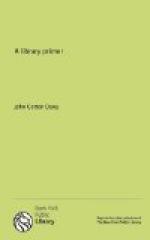If schoolroom libraries do come from the public library, they can with very little difficulty be changed several times during the school year. With a little care on the part of the librarian and teachers, the collection of any given room can be by experience and observation better and better adapted to the children in that room as time goes on.
There are many ways of using the schoolroom library. The books forming it should stand on open shelves accessible to the pupils whenever the teacher gives permission. They may be lent to the children to take home. Thus used they often lead both children and parents to read more and better books than before, and to use the larger collections of the public library. They may be used for collateral reading in the schoolroom itself. Some of them may be read aloud by the teacher. They may serve as a reference library in connection with topics in history, geography, science, and other subjects.
Wherever introduced these libraries have been very successful.
CHAPTER LII
Children’s home libraries
In a few cities the following plan for increasing the amount of good reading among the children of the poorer and less educated has been tried with great success. It is especially adapted to communities which are quite distant from the public library or any of its branches. It is, as will be seen, work which is in the spirit of the college settlement plan. The “home libraries,” if they do no more, serve as a bond of common interest between the children and their parents, and the persons who wish to add to their lives something of interest and good cheer. As a matter of fact they do more than this. They lead not a few to use the library proper, and they give to at least a few boys and girls an opportunity for self-education such as no other institution yet devised can offer.
A home library is a small collection of books, usually only 15 or 20, with one or two young folks’ periodicals, put up in a box with locked cover. The box is so made that it will serve as a bookcase and can be hung on a wall or stood on the floor or a table. In the neighborhood in which it is to be placed a group of four or five children is found—or perhaps a father or a mother—who will agree to look after the books. To one of these, called the librarian, is given the key of the box, and the box itself is placed in the spot selected; perhaps a hallway or a living room. Under a few very simple regulations the librarian lends the books in the home library to the young people of the neighborhood. If the experiment is successful the first set of books is changed for another, and the work continues. Or perhaps the library is enlarged; and perhaps even grows into a permanent institution.
CHAPTER LIII
Literary clubs and libraries
Evva L. Moore, Withers’ public library




